Table of Contents
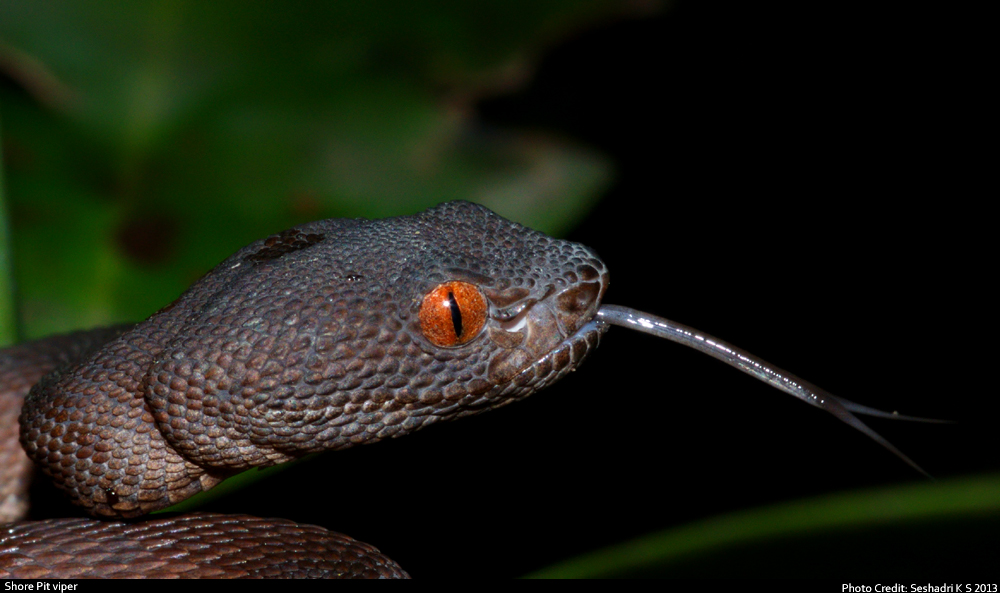 |
| A small individual found at Pasir Ris mangrove. Photo © Seshadri K. S. on Wikipedia Commons |
1. Description
1.1 Etymology
Cryptelytrops purpureomaculatus is also commonly known as the shore pit viper or the mangrove pit viper because it is found in mangrove forests. The term 'purpureo-maculatus' was coined by the original describer John Edward Gray in 1832 because of the purple spots on the particular specimen he was describing, although body pattern and coloration is variable in this species.
| A captive shore pit viper. Photo by myself, 2013 |
1.2 Physical Characteristics
Like all pit vipers, C. purpureomaculatus has a triangular shaped head, vertical slit-like pupils, and heat-sensing pits between the eyes and nose. It also has a prehensile tail, meaning that it can use its tail to grip onto branches, especially when it is striking out at a target.
Diagnostic characters as described by Leviton et al. (2003).
- Scales in 25-27 longitudinal rows at midbody;
- 11-13 upper labials, the first partially or completely united with the nasal;
- supraocular very narrow, sometimes broken into small scales, 12-15 scales between them;
- head scales small, subequal, tuberculate or granular;
- temporal scales keeled;
- body color may be highly variable,
- top: olive, grayish to dark purplish brown,
- underside: whitish, greenish or brown, uniform or spotted with brown;
- a light line on scale row one bordering ventrals present or absent;
- head olive, heavily suffused with brown;
- ventrals: male 160-179, female 168-183;
- subcaudals male 74-76, female 56-63, paired;
- hemipenes without spines.
- Total length male 66.5 cm, female 90 cm; tail length male 12.5 cm, female 14 cm.
Confused? Check out this key by Clarke et al., (2012) from Whitman College to help you understand the characters listed. Though it is specific to Australian and South African snakes, it is useful enough to help in this case.
Here is an additional page by Stewart Macdonald with more useful diagrams.
An original description by Gray (1832) cannot be found online, but the earliest known description, by Cantor (1847), can be found in the additional notes.
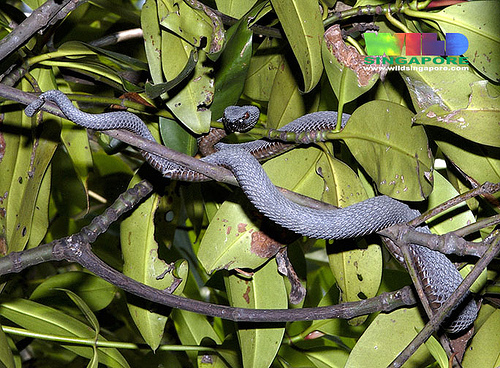 |
| Photo showing off the prehensile tail of the shore pit viper. Photo © Ria Tan. Used with permission. |
1.3 Behaviour
Arboreal, but may be found on mangrove mud amongst roots sometimes, as shown in the second picture on the left, by Chim CK.
Warning: This snake is thought to be aggressive and quick to strike! Pleae exercise caution when approaching it.
Hence, mangrove walkers should be wary of where they step or brush against. These snakes, because they are not brightly coloured (e.g. like the Wagler's pit viper), tend to go unnoticed if they are coiled and unmoving. They are described to be sluggish, but quick to strike when disturbed. When preparing to strike, the snake has been reported to wag its tail and make slight hissing noises (Cantor, 1847). Its prehensile tail allows it to grab onto a branch while striking out. In the photo by Ria Tan on the left, it is possible to see the prehensile tail on the left side of the photo, wrapped around the branch. The venom from this snake, although generally not fatal to humans, is known to cause pain and swelling.
Shore pit vipers are nocturnal and most active then (Cox et al., 1998; David & Vogel, 1996).
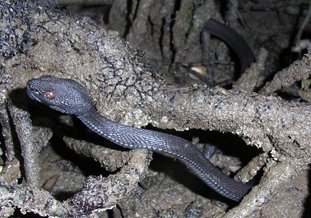
C. purpureomaculatus amidst mangrove roots. Photograph © Chim CK. Used with permission.
1.4 Feeding

These snakes mainly feed on lizards and possibly small birds.
Observations of this species of snake showed that an individual upon being bitten by this snake, a fowl was able to recover in 21 minutes (Cantor, 1847). Hence, it is likely that if the snake feeds on birds, it would be birds much smaller than chickens.
Here is a video of C. purpureomaculatus feeding... but not in nature, unfortunately.
And another video of C. purpureomaculatus shedding. It also offers a good view of the snake striking out.
Videos © Al Coritz (YouTube user viperkeeper). Used with permission.
2. Ecology
2.1 Distribution
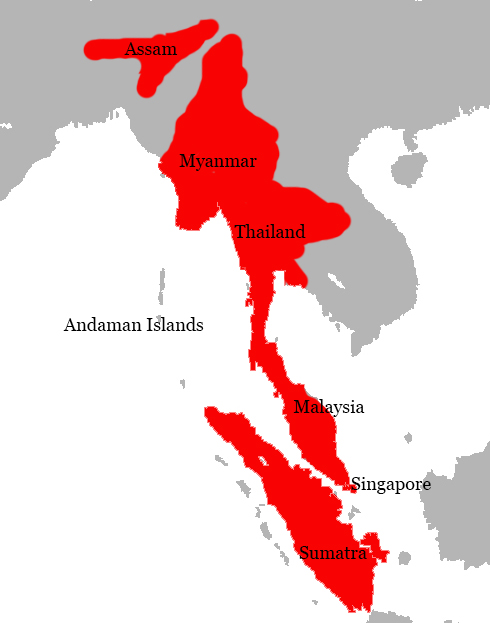
C. purpureomaculatus has been found in India (state of Assam), Myanmar, Thailand, Peninsular Malaysia, Singapore, and Sumatra. It can generally be found at elevations lower than or equal to 10 metres above sea level, in mangroves, coastal swamps and coastal forests, although it can be found in canals and along river banks near to the coast as well (Cox et al., 1998; David & Vogel, 1996).
Since exact distribution has not been mapped, the map on the left serves to generally illustrate the range of this species. The Andaman Islands has been annotated on the map because in the past, a snake species found there was though to be a subspecies shore pit viper, named C. purpureomaculatus andersoni. However, this species was later elevated to full species status, as mentioned in section 3.5 on species confusion.
3. Taxonomy
3.1 Holotype
A holotype is the individual specimen used in the original description, and the one used to delimit the species. This means that if there is any confusion regarding whether a specimen is of this particular species, the holotype will be used as the basis for comparison.
Holotype may be found in the British Museum of Natural HIstory (BMNH) with the reference number 1946.1.19.54. The holotype was collected in Singapore, and a sketch of it may be found in Thomas Hardwicke's Illustrations of Indian Zoology Volume 1 (sketch no. 158). However, the name given on the sketch was "Trigonocephalus purpurcornaculatus [purpureo-maculatus]". Although the sketch itself may not be reproduced on this page, it may be viewed online at the NYPL Digital Gallery site.
3.2 Taxonavigation
C. purpureomaculatus can be classified as such:
| Animalia |
| --Chordata |
| ----Reptilia |
| ------Squamata |
| --------Viperidae |
| ----------Crotalinae |
| ------------Cryptelytrops |
| --------------purpureomaculatus |
3.3 Synonyms
Synonyms are other names that may have been used to refer to the same species over the course of history. It is important to know these synonyms because older resources on this species may have used some of these names, hence finding them would require looking up these names instead.
From the Reptile Database, there are 18 synonyms of the name Cryptelytrops purpureomaculatus.
Cryptelytrops purpureomaculatus (GRAY 1832) is currently the preferred name.
Some synonyms (repeats excluded):
Trigonocephalus purpureo-maculatus (Gray in Gray & Hardwicke,1832) - this is the earliest name given together with a description of the species.
Trimesurus purpureus (Gray,1842)
Trimeresurus puniceus (Cantor, 1847)
Trimeresurus porphyraceus (Blyth,1861)
Trimeresurus purpureomaculatus (Boulenger,1890)
Lachesis purpureomaculatus (Boulenger,1896)
Trimeresurus purpureomaculatus purpureomaculatus (Smith, 1943)
Trimeresurus purpureomaculatus (Manthey & Grossman, 1997)
Cryptelytrops purpureomaculatus (Malhotra & Thorpe, 2004) - after the latest genus revision proposed by them. More information on this may be found in the next two sections.
3.4 Genus Revision and Phylogenetics
For a long time, the name was Trimeresurus purpureomaculatus was widely used. It was in 2004 that Malhotra and Thorpe suggested that the genus be split into seven genera, one of which is Cryptelytrops, based on molecular evidence using cytochrome b sequences as well as the study of hemipenis morphology. A review by David et al. (2011) suggested that whether these seven taxa are full genera or subgenera should be open to discussion. The authors agree that if lumped into one genera with seven subgenera, the phylogenetic relationships would be misrepresented. However, the authors also argue that the seven genera are also more closely related to each other than to other genera within the subfamily Crotalidae (pit-vipers). As such, they suggest that if the seven genera are to be recognised as valid, they should still be grouped into a single higher taxa to reflect this closeness in relationship.
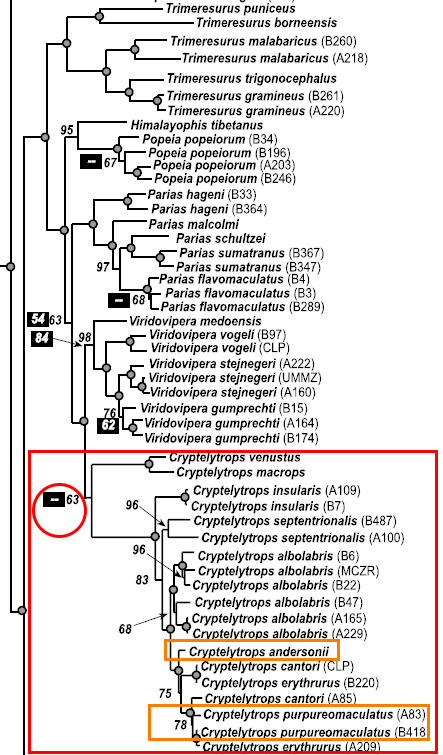 |
| Phylogenetic tree adapted from Castoe & Parkinson, 2006. |
The phylogenetic tree on the left is the result of a Bayesian mixed-model study by Castoe and Parkinson in 2006. The splitting of Trimeresus into seven genera by Malhotra and Thorpe (2004) was supported by Castoe and Parkinson. In the red circle, it is apparent that there is relatively low support for the monophyly of the genus Cryptelytrops, as compared to the other proposed genera. However, the monophyly is still supported by morphological evidence of head scalation and hemipenis structure (Malhotra & Thorpe, 2004).
On a separate note, the tree also illustrates how C. purpureomaculatus is distinct from C. andersoni, as will be mentioned in the next section.
3.5 Subspecies and species confusion in literature
There exists a high level of geological variation and sexual dimorphism in the group of pit-vipers historically grouped under the genus Trimeresurus (Malhotra & Thorpe, 1997). Hence, it is unsurprising that some species confusion has occurred over the years. As such, this section aims to list instances of taxonomic confusion so as to help readers navigate literature more easily, should they choose to do so.
A 1992 paper by Warrell et al. exposed the fact that a distinct species of pit-viper, C. (then called Trimeresurus) kanburiensis, was being mislabelled as C. purpureomaculatus both in literature, as well as in practice e.g in snake farms. The difference is important because a C. kanburiensis bite caused a woman to be hospitalised for 4 days, and may potentially be more harmful to young children and elderly persons as compared to the bite of C. purpureomaculatus. It is hence important to note that literature before 1992 may have mentioned C. purpureomaculatus when referring to C. kanburiensis.
Cryptelytrops purpureomaculatus had two subspecies - C. purpureomaculatus purpureomaculatus which was found in India, Myanmar, Thailand, Malaysia, Singapore and Sumatra, and C. purpureomaculatus andersoni (Smith, 1943), which was only found in the Andaman Islands. C. purpureomaculatus andersoni has since been raised to full species level because they were found to be distinct from C. purpureomaculatus (Malhotra and Thorpe, 1997). Thus, when accessing literature from before 2004, it is advisable to note the locality of C. purpureomaculatus as those in the Andaman Islands would really be C. andersoni.
4. Conservation status
According to the IUCN Red List, this species is ranked to be of least concern, because it is widely distributed and abundant. Populations are also relatively unaffected by human activity.
5. Use in Medical Research
5.1 Venom activity
Studies of snake venom are interested in things like lethality (tested on mice), coagulant or anticoagulant activity, thrombin-like activity, hemorrhagic activity and other enzymatic activity. These factors can be used to differentiate between the venom of different snake species.
Lethality: C. purpureomaculatus venom was found to be relatively highly lethal compared to other Asian pit-vipers in the (historical) Trimeresurus genus (Tan, Armugam & Tan, 1989).
Hemorrhagic activity: Exceptionally strong hemorrhagic effect produced in mice (Chanhome et al., 2001; Tan et al., 1994; Tan, Armugam & Tan, 1989).
Thrombin-like activity: Strong to moderate (Tan, Armugam & Tan, 1989).
The thrombin-like enzyme in the venom was isolated and characterized, and termed purpurase. Anti-purpurase raised from the venom was found to cross-react with venoms of other pit-vipers in the former Trimeresurus genus (now seven genera), but not with that of other crotalids. Hence, this lends support to the notion that the seven genera are more closely related to each other than to other genera of pit-vipers (Tan, 2010).
Anticoagulant activity: Moderate (Tan, Armugam & Tan, 1989).
Phosphodiesterase activity: High (Tan, Armugam & Tan, 1989).
Phospholipase activity: Moderate (Tan, Armugam & Tan, 1989).
Phospholipase A2 was isolated from the venom of C. purpureomaculatus and studied for its edema-forming capability. However, the crude venom produced stronger edema formation than the isolated phospholipase from the venom, hence implying that phospholipase only plays a partial role in the edema forming ability of C. purpureomaculatus venom (Tan, Tan & Khor, 1989).
Hyaluronidase activity: Low (Tan, Armugam & Tan, 1989).
Protease activity: High (Tan, Armugam & Tan, 1989).
5' Nucleotidase activity: High (Tan, Armugam & Tan, 1989).
Arginine ester hydrolase activity: Moderate (Tan, Armugam & Tan, 1989).
L-amino acid oxidase activity: Moderately high (Tan, Armugam & Tan, 1989).
5.2 Medical use
A recent study by Pongchairerk et al. (2009) suggested that C. purpureomaculatus venom may be useful in inducing lung cancer cell death because of its phospholipase activity. However, they recommended further studies and trials to confirm the results and to determine the correct dosage so as to minimise the side effects of the venom.
6. Additional Notes
6.1 Species description by Cantor (1847)
This description is placed here because a more thorough, diagnostic one has been given by Leviton et al., (2003) above.
In his entry in the Asiatic Society of Bengal's Catalogue of the Reptiles Inhabiting the Malayan Peninsula and Islands, Volume 16(2) (1847), Cantor calls this species Trigonocephalus puniceus, while listing the synonym Trigonocephalus purpureomaculatus (Gray, 1832). This is a case of species confusion. The description is as follows:
Dull reddish-brown or olive tinged with purple; in some an indistinct black line from the eye to the sides of the neck; the scales dotted or finely marbled with black, their keels pale ochre; the posterior part of the trunk and tail with irregular dark brown spots; the interstitial skin reddish brown, lighter or darker than the scals, and beneath pale greenish yellow; scuta and scutella with brown margins, the latter largely spotted with brown. Iris greenish golden marbled with black; pupil elliptical vertically contracted by the light; tongue light brownish grey.
Scuta 162 to 171; Scutella 65-70
Habitat - Pinang, Malaysian Peninsula, Singapore, Java
The malayan individuals differ slightly from the javanese in having very few dark spots and no reddish line above the black one on the sides of the head. The oval gular scales have a tubercular appearance. The integuments of the head and body are remarkably lax, like those of Acrochordus javanicus. The neck is covered by 31, the trunk by 27 longitudinal series of ovate or conical scales; they are not imbricate, but are frequently surrounded by the naked skin. The tail is prehensile, but less so than in the preceding species. The malayan individuals appear to be less numerous than the javanese. The four observed were all found on the ground in valleys. The largest, which had been feeding on a rat, was of the following dimensions:
Length of the head: 0ft 1 4/8 inch
Length of the trunk: 2 ft 5 3/8 inch
Length of the tail: 0 ft 5 4/8 inch
Total: 3 ft 0 3/8 inch
Circumference of the neck: 2 inch
Circumference of the trunk: 3 4/8 inch
Circumference of the root of the tail: 1 3/8 inch
7. Useful Links
Adventurers may check out the SGSnakes mobile app by the Wildlife Reserves Singapore Conservation Fund. iPhone version. Android version.
Browse images of the shore-pit viper on Flickr!
In case you missed it earlier, here are the links to the snake character key by Clarke et al. (2012), and the AROD snake scale count page by Stewart Macdonald.
8. References
Cantor TE. 1847. Catalogue of Reptiles Inhabiting the Malayan Peninsula and Islands. Journal of the Asiatic Society of Bengal, 16(2): 1043-1046.
Castoe TA, Parkinson CL. 2006. Bayesian mixed models and the phylogeny of pitvipers (Viperidae: Serpentes). Molecular Phylogenetics and Evolution, 39: 91–110.
Chanhome L, Khow O, Omori-Satoh T, Sitprija V. 2001. Efficacy of Thai green pit viper antivenom against Thai Trimeresurus snake venoms and comparison of biological activities of these venoms. Toxicon, 39: 148-149.
Clarke DN, Kunkel W, Chippaux JP, Jackson K. 2012. Online multivariate key to the snake genera of Western and Central Africa. Online: http://people.whitman.edu/~clarkedn/ (Accessed: 26th November 2013)
Cox MJ, van Dijk PP, Nabhitabhata J, Thirakhupt K. 1998. A Photographic Guide to Snakes and Other Reptiles of Thailand and South-East Asia. Asia Books, Bangkok.
David P, Vogel G. 1996. The snakes of Sumatra. An annotated checklist and key with natural history notes. Bücher Kreth, Frankfurt/M.
David P, Vogel G, Dubois A, 2011. On the need to follow rigorously the Rules of the Code for the subsequent designation of a nucleospecies (type species) for a nominal genus which lacked one: the case of the nominal genus Trimeresurus Lacépède, 1804 (Reptilia: Squamata: Viperidae). Zootaxa, 2992: 1–51.
Gray JE. 1831. Illustrations of lndian Zoology: chiefly selected from the collection of Major General Hardwicke, Vol. 1, London (1830-1835).
Leviton AE, Wogan GOU, Koo MS, Zug GR, Lucas RS, Jens V. 2003. The Dangerously Venomous Snakes of Myanmar Illustrated Checklist with Keys. Proceedings of the California Academy of Sciences, 54 (24): 407–462.
Macdonald S. (No year). Australian Reptile Online Database: Snake Scale Count Search. Online: http://www.arod.com.au/arod/scale/ (Accessed: 26th November 2013)
Malhotra A, Thorpe RS. 1997. New perspectives on the evolution of South-East Asian pitvipers, genus Trimeresurus from molecular studies. In: Thorpe, R.S., W€uster, W., Malhotra, A. (Eds.), Venomous Snakes, Ecology, Evolution and Snakebite. Symposium of the Zoological Society of London, 70: 115–118.
Malhotra A, Thorpe RS, 2004. A phylogeny of four mitochondrial gene regions suggests a revised taxonomy for Asian pitvipers (Trimeresurus and Ovophis). Molecular Phylogenetics and Evolution, 32: 83 –100 [erratum p. 680].
Pongchairerk U, Chantakru S, Pongket P, Saengprapaitip K, Doungern A. 2009. Morphological changes of apoptosis in the Human Cholangiocarcinoma Cell Line, HuCCA-1, induced by green pit viper venom. Natural Science, 43: 77-84.
Pope CH, Pope SH. 1933. A study of the green pit-vipers of southeastern Asia and Malaysia, commonly identified as Trimeresurus gramineus (Shaw), with description of a new species from Peninsular India. American Museum of Natural History, 620: 1-12.
Smith MA. 1943. The Fauna of British India, Ceylon and Burma, Including the Whole of the Indo-Chinese Sub-region. Reptilia and Amphibia, Vol. III.—Serpentes. Secretary of State for India. (Taylor and Francis, Printers.) London. 583 pp.
Tan NH, Armugam A, Tan CS. 1989. A comparative study of the enzymatic and toxic properties of venoms of the Asian lance-headed pit-viper (Genus Trimeresurus). Comparative Biochemistry and Physiology, 93B(4): 757-762.
Tan NH, Choy SK, Chin KM, Ponnudurai G. 1994. Cross-reactivity of monovalent and polyvalent Trimeresurus anti-venoms with venoms from various species of Trimeresurus (lance-headed pit viper) snake. Toxicon, 32: 849-853.
Vogel, G., Grismer, L. & Chan-Ard, T. 2012. Cryptelytrops purpureomaculatus. In: IUCN 2013. IUCN Red List of Threatened Species. Version 2013.2. <www.iucnredlist.org>. Downloaded on 24 November 2013.
Warrell DA, Looareesuwan S, Stimson AF, Hutton RA. 1992. Rediscovery and redefinition of Malcolm Smith’s Trimeresurus kanburiensis in Thailand, with a report of envenoming. Transactions of the Royal Society of Tropical Medicine and Hygiene, 86: 95-99.